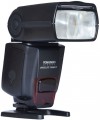Reload time
The time it takes the flash or generator (for studio flashes) to prepare for the next flash. The smaller it is, the better. This parameter is especially important for continuous shooting, when the interval between frames is small: if you often shoot in this mode, you should look for a flash with the shortest possible recycle time. Also note that the characteristics usually indicate the shortest recharge time; in some operating modes, it may be significantly more than stated.
Pulse duration
The duration of the pulse of light provided by the flash. This indicator can range from thousandths to hundred thousandths of a second; it is usually expressed as a fractional number with a unit in the numerator, such as 1/880 s. The human eye does not notice the difference, but in some shooting modes it can become critical. For example, to capture fast-moving scenes (such as splashing water, the flight of an insect, or the movement of machine parts) you need to choose a flash with the shortest flash duration possible — otherwise the image may be blurry.
The longest pulse duration in modern photoflashes is about 1/800 s; the minimum value can reach 1/30,000 s or even less.
Features
—
Autofocus assist light. The presence of an auxiliary illumination function in the flash for the camera's autofocus system. Modern cameras in the vast majority use the so-called passive autofocus systems, which have one serious drawback: very low efficiency in low light and/or low contrast of the subject being photographed. Autofocus assist light is designed to solve this problem: before focusing, the scene is illuminated by a separate lamp, located, in this case, directly in the flash body. This ensures a sufficient amount of light for normal autofocus operation. Most often, the backlight lamps give off light of a characteristic reddish hue, but some advanced models use infrared illumination - invisible to the eye, but perceived by the camera. In addition, backlight systems can use a special light pattern instead of a solid beam, which further simplifies the task of autofocus systems. In any case, the presence of this function is especially important given that the flash is often used as a light source in low light.
— On-camera control. The ability to change the flash settings using the controls of the camera to which it is connected. In some cases (for example, with a wireless connection), this is much more convenient than switching attention from the camera to the flash.
—
Automatic zoom. The ability to automatically change the flash light scattering angle. For the scattering angle
..., see the corresponding point above, but here we note that this function provides synchronization between the flash and the lens: when the focal length of the lens changes, the scattering angle automatically changes. This ensures the most effective illumination of the scene and at the same time saves you from having to manually readjust the flash each time to the changed viewing angle.
— Manual zoom. The ability to change the flash spread angle (see "Light spread angle") manually. This function expands the possibilities for "fine" adjustment of operating parameters and allows you to set parameters that are not available with automatic zoom (see above). In addition, it will be useful if you have to use several fixed lenses with different focal lengths - the flash can be easily adjusted for each of them.
— Operation in master mode. The ability to operate the flash as a master for a system of several flashes. The entire system is controlled via the master flash, the parameters of the slave flashes are set, and the command to fire is given (note that the master flash itself may not give a pulse at all). If you plan to shoot using a system of several flashes, you will definitely need a model with this function — without it, creating a system is impossible. Of course, the master and slave flashes must be mutually compatible; this point should be clarified separately.
— Slave mode. The ability to operate the flash as a slave in a system of several flashes. In this mode, the device is connected to the master flash and is triggered by a command from it. For more information on flash systems, see "Master mode operation" above.
— Radio synchronizer. A device designed for wireless control of a flash or a set of flashes (if each of them has its own receiver). Usually it is a separate module installed in a hot shoe; upon a command to trigger, this module sends a radio signal to all receivers tuned to it, ensuring synchronous triggering of the flashes. At the same time, some models of lamps with this function are capable of receiving via radio not only the trigger signal, but also the operating parameters (primarily the duration and power of the pulse).Wireless control
The ability to wirelessly connect the flash to the camera or to another flash as a master/slave (if such functions are available, see below). The format and specific features of such a connection may vary: wired connection, IR channel, radio, etc.
Wireless control is indispensable if the flash needs to be placed away from the camera; it also facilitates the creation of systems from several flashes for organizing optimal lighting. These capabilities are especially useful for studio shooting (although this is not the only thing).

